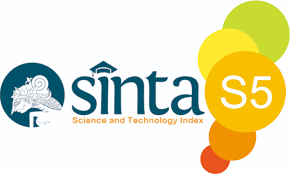Penerapan Metode Promethee Dalam Rekomendasi Pemilihan Karyawan Berprestasi
Abstract
In every company there is an employee performance assessment system that is used to find out who can be used as role models as outstanding employees. The assessment aspects are divided into 4 categories, namely Discipline, Work Attitude, Potential and Ability, and Work Results. In this decision support system the Promethe method has been applied, so that the final assessment results for each employee have gone through the Promethe method calculation procedure. The final assessment results of the Promethee Method will be sorted from the highest value to the lowest value with two conditions where if the Net Flow value is all 0 then it will be sorted based on the leaving flow and entering flow values, but if the Net Flow value is not all 0, then it will be sorted based on Net Flow value obtained from each employee
Downloads
References
[2] T. Limbong, Muttaqin, A. Iskandar, A. P. Windarto, J. Simarmata, Mesran, O. K. Sulaiman, D. Siregar, D. Nofriansyah, D. Napitupulu and A. Wanto, Sistem Pendukung Keputusan : Metode dan Implementasi, Medan: Yayasan Kita Menulis, 2020.
[3] R. Watrianthos, Kusmanto, E. Simanjorang, M. Syaifullah and I. R. Munthe, "Penerapan Metode Promethee Sebagai Sistem Pendukung Keputusan Pemeringkatan Siswa," Jurnal Media Informatika Budidarma , Vols. Vol.3 No.4 ISSN:2614-5278, 2019.
[4] A. Blazing, Pemrograman Windows Dengan Visual Basic .Net : Praktikum Pemrograman VB.Net, Google Book, 2018.
[5] A. D. Hardiansyah and C. N. P. Dewi, "Perancangan Basis Data Sistem Informasi Perwira Tugas Belajar (SIPATUBEL) Pada Kementrian Pertahanan," Jakarta, 2020.
[6] Kadarsih and D. Pujianto, Step By Step Belajar Database MySQL Untuk Pemula, Tangerang Selatan: Pascal Books, 2022.
[7] A. Firman, Analisis dan Perancangan Sistem Informasi, Surabaya: Penerbit Qiara Media, 2019.
[8] U. Suprapto, Pemodelan Perangkat Lunak (C3) Kompentesi Keahlian : Rekayasa Perangkat Lunak Untuk SMK/MAK Kelas XI, Jakarta: Grasindo, 2021.
Copyright (c) 2024 Dimas Aulia Trianggana; Indra Kanedi

This work is licensed under a Creative Commons Attribution-ShareAlike 4.0 International License.
An author who publishes in Jurnal Media Infotama agrees to the following terms:The author holds the copyright and grants the journal the right of first publication of the work simultaneously licensed under the Creative Commons Attribution-Share Alike 4.0 License which allows others to share the work with acknowledgment of the work's authorship and initial publication in this journal.Submission of a manuscript implies that the submitted work has not been previously published (except as part of a thesis or report, or abstract); that it is not being considered for publication elsewhere; that its publication has been approved by all co-authors. If and when a manuscript is accepted for publication, the author retains the copyright and retains the publishing rights without limitation.
For new inventions, authors are advised to administer the patent before publication. The license type is CC-BY-SA 4.0.
MEDIA INFORMATION REVIEW: Journal of the Faculty of Computer Science is licensed under a Creative Commons Attribution-ShareAlike 4.0 International License.You are free to:Share
— copy and redistribute material in any medium or formatAdapt
— remix, modify and develop materialfor any purpose, even commercial.
The licensor cannot revoke this freedom as long as you follow the license terms












.png)


